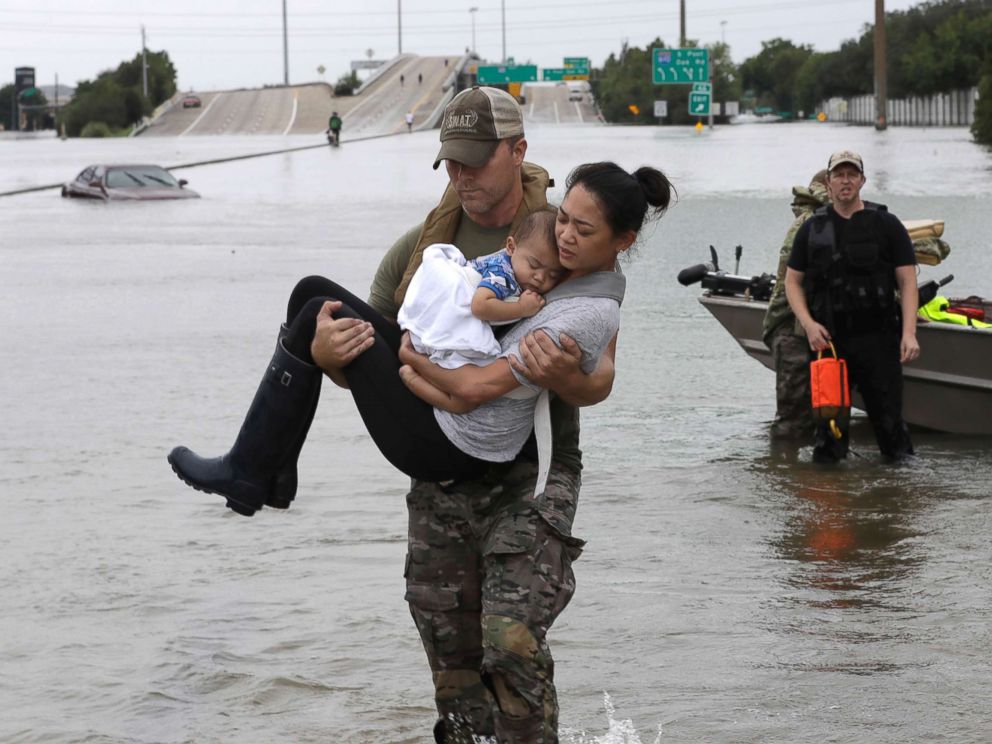
Image Credit: David J. Phillip/AP
The United States, and Texas specifically, is still in the dramatic stillness that has followed in Hurricane Harvey’s wake. It will be years before we are able to fully understand the magnitude of the impact of the storm.
Harvey was a level four storm and it was the wettest tropical cyclone on record to touch down in the contiguous United States. Southern parts of Texas still sit under flood waters; the amount of area that experienced flooding was larger than New York City and Chicago combined. So far, 70 people have been confirmed dead.
And in terms of economics, Doyle Rice of USA Today notes, “Hurricane Harvey could be the costliest natural disaster in U.S. history with a potential price tag of $190 billion, according to a preliminary estimate from private weather firm AccuWeather.”
Beyond the finances and the numbers, we wait to understand the total impact of Harvey on the environment.
Estel Masangkay of The Environmental Blog noted after Hurricane Sandy, “For many, Sandy was an environmental wake-up call. The superstorm has exposed vulnerabilities in technologically advanced, First World cities thought to be capable of handling crises. Power failures, infrastructure damage, floods, and communication line cutoffs opened eyes to the challenges of climate change and extreme weather events.”
Perhaps Harvey is having a similar moment in the minds of both those committed to being eco-friendly, as well as others who may not have given it much thought until now.
The Impact on the Land
The animals that live along land that is hit by a hurricane virtually always suffer. Hurricanes defoliate forest canopies and alter the ecosystems in wooded areas. Thus, if animals are not killed by the storm, then they will likely suffer the consequences of a change to their habitat and food availability.
“An unknown number of wild animals have been injured and displaced by Hurricane Harvey,” says Joan Morris of The Mercury News, “Wildlife care centers in the flooded areas have been inundated with orphaned and injured wild animals. One center alone, the Austin Wildlife Center, received more than 200 orphaned baby squirrels in three days. The Dallas Zoo has taken in more than 4,000 animals.”
Clearly, Harvey has touched everyone, even of the four-legged and winged variety.
The Arkema Spill
What was already a dire situation was made even more so when an Arkema chemical plant in Crosby, Texas lost power. Steven Mufson of The Washington Post noted, “Its refrigeration system and inundated backup power generators failed, raising the possibility that the volatile chemicals on the site would explode.”
Essentially, the cooling system that kept the chemicals at a safe temperature had stopped working, this after the plant was already submerged under six-feet of water.
On August 31st the plant suffered multiple explosions, and the consequences at this early date are still unknown. Troubling, though, has been the discovery that earlier this year OSHA fined the plant approximately $100,000 for safety violations.
This, in the state that Eastern Kentucky University found is most likely to experience a natural disaster, Texas has suffered 86 major disasters, more than any other state.
The Water Contamination
But Arkema, while the most extreme example, is not alone in participating in the possible contamination of the water supply.
Hiroko Tabuchi of The New York Times lays out the main stressors, “Flooded sewers are stoking fears of cholera, typhoid and other infectious diseases. Runoff from the city’s sprawling petroleum and chemicals complex contains any number of hazardous compounds. Lead, arsenic and other toxic and carcinogenic elements may be leaching from some two dozen Superfund sites in the Houston area.”
And of course, this isn’t just scary for the people, but for the native animals and plants that have been flooded by waters containing harmful components. As those committed to reducing water pollution know, contaminated surface water oftentimes leads to contaminated groundwater.
The Rebuild Efforts
While the storm caused brief closures in what has become one of the main oil hubs of the U.S., what comes next will require much of that very oil. Ultimately, what everyone hopes for the areas impacted by Harvey, is that they are able to rebuild quickly and efficiently and that they are able to achieve some level of normalcy sooner rather than later.
Experts predict that as people and businesses receive insurance money, there will be a boom in Houston’s economy, at least in the early months. And that’s good. What’s not so good is that the rebuilding process is going to bring an inevitable consequence, as the machines and vehicles that are essential to construction are used far more than is typical in a given area. And that, of course, is going to mean an excess of air pollution.
The good news, though, is that rebuilding can be done in a way that has long-term, positive effects for the planet. Hopefully, the Houston area, a quickly growing metropolis, will utilize this moment in time to rebuild in an eco-friendly direction. Afterall, New Orleans responded to the damage done by Hurricane Katrina, and managed to make it one of the top city turnarounds in the U.S.
Hurricane Harvey and the rest of the world.
Ultimately, this is a sobering moment both for those in Texas, as well as those who live far from the flood waters. It’s a reminder that Mother Nature is truly unstoppable and unpredictable. Even if one doesn’t live along the coast it’s a fitting time to consider how best to prepare for the natural disasters that are within the realm of possibility.
Whether it be from hurricanes, tornadoes, earthquakes, etc., we should all do well to take the steps we can to ensure our homes are prepared for a natural disaster. And beyond the practical steps, how are we as a society preparing for disasters in an environmentally-conscious manner?
The importance of this one question will no doubt continually be made clear as Hurricane Harvey’s impact stretches out into the coming months and years.





Leave a Comment